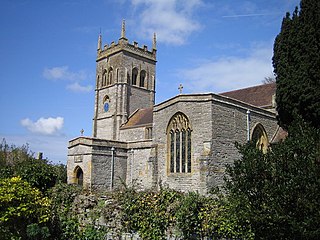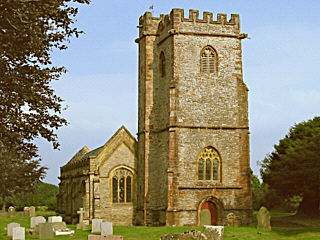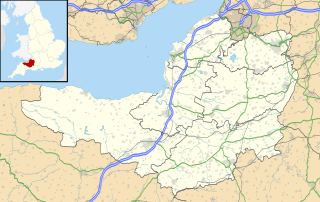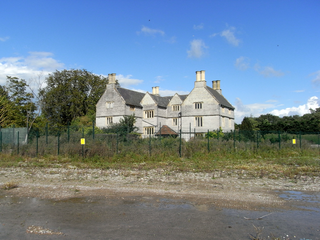
Chedzoy is a civil parish village 3 miles (4.8 km) east of Bridgwater in the Sedgemoor district of Somerset.

Spaxton is a small village and civil parish on the Quantocks in the Sedgemoor district of Somerset, South West England.

The Church of St Mary & All Saints in Broomfield, Somerset, England was built in the 15th and 16th centuries and has been designated as a Grade I listed building.

The Church of St Mary is the parish church of Cannington, Somerset, England. The parish is in the Church of England Diocese of Bath and Wells.

The Church of St Margaret in Spaxton, Somerset, England has some parts from the 12th and 13th centuries but is predominantly from the 15th century, and was restored in 1895. It has been designated as a Grade I listed building.

The Church of St Mary in North Petherton, Somerset, England dates from the 15th century and has been designated as a grade I listed building. It is on the Heritage at Risk Register due to the condition of the roof and north aisle parapet.

The Corn Exchange and market house in Bridgwater, Somerset, England was built in 1834 by John Bowen and extended in 1875, by Charles Knowles. It has been designated as a Grade I listed building.

Gothelney Hall, also known as Gothelney Manor Farmhouse, located in the parish of Spaxton, Somerset, England was built in the 15th century and has been designated as a Grade I listed building.

Buckland Priory was established around 1167 in Lower Durston, Somerset, England.

The Hundred of Andersfield is one of the 40 historical Hundreds in the ceremonial county of Somerset, England, dating from before the Norman conquest during the Anglo-Saxon era although exact dates are unknown.
The Somerset Victoria County History is an encyclopaedic history of the county of Somerset in England, forming part of the overall Victoria County History of England founded in 1899 in honour of Queen Victoria. With ten volumes published in the series A History of the County of Somerset, the Somerset VCH is among the most substantial of the Victoria County Histories.
Alfred of Spain was a Norman lord recorded in the Domesday Book. He held land mainly in Somerset but also in Devon, Dorset, Wiltshire, Gloucestershire and Herefordshire. He was not from Spain but from Épaignes in Normandy. The Domesday scribes rendered his name into Latin as Alvredi De Ispania as a kind of word play and in English his name is written variously Alfred or Alvredof or de Spain, Hispania or Ispania. It has been suggested that he may have built the castle at Nether Stowey or possibly an earlier one which has disappeared at Over Stowey. Much of his land was the pre-conquest estate of a Saxon lord Alfwy although the important manor of Stowey had been held by King Harold.

Church Of St Peter And St Paul in Over Stowey, Somerset, England is the Anglican parish church for the ancient parish of Over Stowey, now part of the Quantock Villages Benefice in the Diocese of Bath and Wells.

Walford is a small village 3 miles (5 km) north east of Taunton in Somerset, England. Most of the village, including Walford Cross at the junction of the A38 and the A361, lies in the civil parish of Creech St Michael. The western part of the village, including Walford House, is in the civil parish of West Monkton. The village lies close to the A38 and the M5 motorway.

Petherton Park was a Deer park around North Petherton within the English county of Somerset.

Sydenham House, the manor house of the ancient manor of Sydenham in the parish of Wembdon, Somerset, England, is a grade II listed building, constructed in the early 16th century and refronted and rebuilt after 1613. In 1937, British Cellophane Ltd set up production and built extensive factories on 59 acres (24 ha) of land adjacent to the manor house. Production ceased in 2005 and between 2010 and 2015 the industrial site was razed to the ground. In 2015 the razed site is owned by EDF Energy, which in 2012 purchased the manor house with the former factory site, intended for construction of temporary accommodation for 1,000 workers.

The Norman Anglican Church of St Giles in Thurloxton dates from the 14th century but is predominantly from the 15th century with 19th-century restoration including the addition of the north aisle in 1868. It has been designated by English Heritage as a Grade II* listed building.

West Bower Manor in Durleigh within the English county of Somerset was largely built in the 15th century. It is a Grade II* listed building.

The Church of St Hugh at Durleigh in the English county of Somerset was built in the 11th century. It is a Grade II* listed building.

The Anglican Church of St Peter in North Newton within the English county of Somerset has a tower believed to date from Saxon times. It is a Grade II* listed building.

















